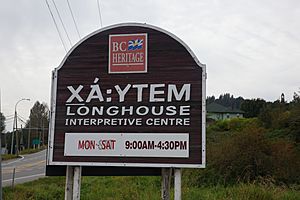X̱á:ytem facts for kids
Quick facts for kids X̱á:ytem |
|
|---|---|

Sign for the X̱á:ytem Longhouse Interpretive Centre
|
|
| Location | Hatzic, Mission, British Columbia, Canada |
| Current use | Active archaeological site and museum |
| Designated | 4 June 1992 |
X̱á:ytem (pronounced "Hay-tem" or "Ha-ee-tem") is a very old and special place in Hatzic, British Columbia, Canada. It is an archaeological site, which means it's a place where scientists study human history by digging up old objects. This site also has a museum run by the Stoːlo people, who are the Indigenous people of this area.
X̱á:ytem is about 80 kilometers east of Vancouver. You can find it near the town of Mission. This site is super important because it's one of the oldest places where people lived in North America, going back about 5,000 years! Because of its deep spiritual meaning to the Stoːlo people and its ancient history, X̱á:ytem was named a national historic site of Canada in 1992. It's also known as Hatzic Rock National Historic Site.
Contents
Discovering X̱á:ytem's Past
For thousands of years, Indigenous people lived along the northern bank of the Fraser River. The Stoːlo people were living here when European settlers first arrived.
How the Site Was Found
Over many years, after the land was settled by others, the X̱á:ytem area was used as a pasture for animals. It was right next to a highway built a long time ago. When the land was sold to a builder, and they started preparing it, people worried about what might be hidden underground.
A person named Gordon Mohs looked into it. He made an amazing discovery: the site was incredibly ancient! It turned out to be one of the oldest known places where people lived in North America.
Protecting the Site
After this important discovery, the government worked to give the land back to the Stóːlō people. This was so they could use it for archaeological studies and to build a museum. The original owner was paid for the plans they had to build houses there.
The Stóːlō people then built the X̱á:ytem Longhouse Interpretive Centre. This museum helps visitors learn all about the site and the rich history of the Stóːlō people.
The Story of Hatzic Rock
One very important and spiritual part of the X̱á:ytem site is Hatzic Rock. This is a huge boulder. In Stoːlo stories, this rock represents three Stoːlo leaders. The stories say that a powerful transformer god named XaːIs turned these leaders into stone.
What Scientists Found
Scientists have worked closely with the Stóːlō people to dig at the site. They have found amazing things! They discovered signs of rectangular pit-houses or longhouses. These were homes where people lived for a long time.
Inside these ancient homes, they found remains of wooden posts, hearths (fireplaces), and floor areas. They also found objects that showed people traded with others. There were remains of food, storage areas, and items used for spiritual activities. These findings help us understand how people lived here thousands of years ago.
See also
- Archaeology of the Americas – The study of human history in the Americas.
- Arlington Springs Man – Ancient human remains found in California.
- Calico Early Man Site – An archaeological site in California.
- Cueva de las Manos – A cave in Argentina famous for ancient hand paintings.
- Fort Rock Cave – An archaeological site in Oregon.
- Kennewick Man – Ancient human remains found in Washington state.
- Marmes Rockshelter – An archaeological site in Washington state.
- Paisley Caves – An archaeological site in Oregon.

